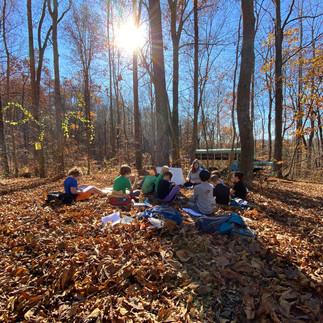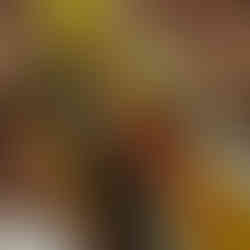November at GAP School!
- Melissa Laurie
- Dec 2, 2022
- 8 min read
Yellow Snakes & Green Goblins
ELA
This month in ELA, we have been diving into our PBL by story writing & illustrating, exploring winter descriptive words, and researching different cultures in the wintertime.
Kindergarten
November flew by! The Cardinals are almost through the entire alphabet. They ask to learn letter sounds and are excited to start building and reading words! In November they learned the letter sound and formation for K, O, W, Z, P, and U. We did beginner sound games and even acted out a story called "Going on a Leaf Hunt". We continue to practice, practice, practice our handwriting and sounds daily. We really enjoyed playing a game called "Action Word Alphabet" where they received an action word(adverb) like “clap” and they had to say it, do it, then tell us what letter the word started with.
The Cardinal group has used their creativity as they wrote a short story about a silver fox who lives at GAP School in the winter. Through this project, they have worked together to formulate sentences, practiced handwriting by tracing letters, and done copy work. They felt a lot of pride in creating their very own GAP short story.
First Grade
The Sparrows started November by finishing a Cauldron project from October. They had to choose different icky ingredients to make a soup in the cauldron, write a recipe, and write how to prepare it. Ask your Learners about fish lollipops and cheesy ice cream! The first graders are starting to write a lot more. Early in November we did a "read then draw" activity and have been doing a lot of handwriting practice in our journals. We have begun CVC word review and are adding in an extra element; changing the first, middle, or end sound to make new words. We read books under the tree and have great discussions about the characters, settings, problems, and solutions.
The Sparrow group has been creating a guide on what winter will feel like at GAP school. This group has worked together by writing sentences, illustrating their words, and creating labels. They have even started working on an 'about the author' page! Get to know these amazing authors and get prepared from some GAP winter fun!
Second Grade
The Ravens & Hawks have completed their first book of the school year, The Dragon Defenders. We did book reviews and reports, and since the book left us hanging we are anxious to start the sequel. We are practicing L blend words, ABC order, sentence writing, and paying attention to descriptive words and similes. We practiced this by using adjectives in our writing about a given setting. The Ravens and the Hawks have started researching different cultures in order to gather information to create a skit. We are working on taking pride in our work by taking our time, writing our best, and completing our work.
All of the groups ended November discussing “What do animals do to prepare for winter?" and "What do animals do in the winter?”. We discussed how nature tells us what season it is and what signs to look for. Look for Your Learner's research projects on animals of their choice at the next Community Day.
Math

We love addition!
In November, the Cardinals worked on adding up to 10 with nuts. They have also worked on their counting and number writing skills! Sparrows added up to 20. They have been practicing two digit by one digit addition and comparing numbers. The Hawks and Ravens spent time on two digit by two digit addition. The Hawks, Ravens, and Sparrows have been focused on their vertical addition and making sure their math work is neat.
All groups worked on number recognition and measuring of water temperatures. We were surprised to discover that the water at Water Chicken Way is warmer than the water near the Horse Bridge!
To round out November, the Sparrows, Hawks, and Ravens have been documenting the layers they have been wearing at school with bar graphs! The graphs will be on display at the next community day for all to see!
Science

During November, science focused on a few star players from the kingdom of fungi. We began with exploration and discovery — mushroom hunting/ID and learning about lichen. Don’t be surprised if you hear your child call out “eureka!” whilst in the woods… they have probably just found a mushroom. The kids were delighted to learn about the special role mushrooms play in the forest; from their massive underground mycelium network, to their symbiotic relationship with trees, we saw how important (and cool!) nature’s recyclers are!
As our all-school project brought winter preparedness to our attention, we pivoted to studying another fungal friend, mold. Many of the traditional food preservation techniques found around the world were done in efforts to prevent mold and prolong shelf-life throughout the fall and winter. So, in order to know what we are up against, we grew some mold! Three variations of humidity clearly demonstrated how crucial the drying out process is… mold loves water!
Finally, we rounded out our fungal studies by having some practical fun with yeast. As you may have heard (and you probably did, judging by the classes’ excitement) we spent one science lesson baking homemade bread! It was a delicious way to experience an old world craft and learn about fungus at the same time.
Silver Foxes
During the month of November, the Silver Fox class has been immersed in the process of exploring the driving question: How do various cultures prepare for winter? Since our previous unit focused on appreciating and developing our school culture here at GAP, expanding our investigations to consider other cultures makes sense. We have also delved into the concept of winter itself, and the fact that people all over the world experience this season differently, based on their geographical location. This driving question has invited us to think closely about the meaning of the word “prepare”. Each Silver Fox Learner is currently developing a project around a different aspect of the driving question.
In ELA, the Learners are continuing their grammar journey by identifying and analyzing how prepositional phrases can spice up and clarify our written and spoken expression. Sentence diagramming helps Learners understand how prepositional phrases act as adjectives and adverbs in the context of sentences. In their study of word elements, the Silver Foxes are learning the subtle distinctions between similar affixes like anti-, non-, de-, and -un. As the Learners are working on their unit projects they are conducting research about their chosen topics. They are learning how to mine a source (which they will cite to avoid plagiarism) for relevant facts, which they then incorporate into at least one well developed paragraph. These “hamburger paragraphs” include supporting details, elaboration, and transitions – all sandwiched between a clear topic sentence (main idea) and a satisfying conclusion sentence. The Silver Foxes are still reading Elise Carbone’s historical fiction novel Blood On the River: Jamestown 1607. The main character, a young orphan boy named Samuel Collier, provides an opportunity for Learners to follow an interesting character development arc. We are witnessing Samuel learn how to work with others and become part of a community. Parallel to this, the current group read-aloud is Lois Lowry’s The Giver. Both in journal entries and during discussion, Learners are making astute observations and generating insightful questions about both texts. Be sure to ask them about these books!
In Social Studies, Silver Fox Learners are coming to understand the Jamestown settlers’ largely profit-seeking reasons for coming to the New World. This has opened the door to related lessons about the dangers of traveling the Silk Road trade route and the many contributions ancient China made to world culture. Studying the Elise Carbone novel is an effective way for Learners to grasp the complex interactions between the British settlers, who did not adequately prepare for Virginia winters, and the indigenous Powhatan tribe, who initially expected the English to assimilate into their tribe. Upcoming Time Travel investigations will include the Lost Colony of Roanoke (by popular demand), as well as a lesson on the contributions of ancient Egypt to world culture.
Over the past month, we discovered many connections between Science and Math and the driving question about winter preparation. Learners are in the process of discovering the reason for the seasons, which disproves the common myth that the Earth is closer to the Sun in the summer and farther in the winter. In doing so, Learners compared distances for the hemispheres, the impact of the axis tilt, and the placement of constellations to understand the true reason for the seasons. Our driving question has also led us to graph data that compared the sunrise/sunset times and another data set graphing the temperatures in different hemispheres to better understand seasonal change locally and across the globe. Also, Learners continue to practice multiplication and division strategies. This practice has led to discovering the operations behind the perimeter and area of rectangles.
Yellow Snakes, Green Goblins, & Silver Foxes
Projects
November Projects were all about the question "How do other cultures prepare for winter?". Learners started the month with this question in mind. We jumped right in talking about light changes, shadows, silhouettes, winter, and how we prepare for winter here at GAP.
The Yellow Snakes and Green Goblins had fun investigating with light and shadows, using their own tin foil sculptures to see how shadows shift in just one hour. Together we discussed different animals we might see during winter and practiced silhouette stencil chalk rubbings with shapes and animals. We then made our very own black scratch paper using oil pastels and paint. We wrapped up November talking about cave drawings from prehistoric times and how past cultures may have found entertainment during the cold winter days. Learners continue to love the coveted Maker Days! Together we are growing and developing new skills, and have found joy in branching out with different materials and collaborative projects in Maker Days.
The Silver Foxes have been working diligently and with great purpose on their "all school projects". Together we are combining our guiding question, Knowledge Seekers, and traditional art skills into independent projects. Learners have really taken to this collaboration and have not only found motivation and pride in their personal work, but also working together as a team for a common goal. We are excited for you to see all the creations they have designed and worked so hard on for our December Community Day!
Knowledge Seekers
Knowledge Seekers started the month by introducing our new all school driving question: "How do different cultures prepare for winter?". Students explored imagery and artifacts to inspire questions they had about this topic such as: "How is snow made?", "What was the biggest winter storm ever?", "How do you dry food?", and "How do you make candles?". These questions help drive our learning for the remainder of the project.
We then took advantage of the early November warm weather and went to the archery range. Learners spent the week learning and practicing archery. Each day we explored a part of archery connected to how we learn. These included the challenges of learning a new skill, thinking through our body position when shooting, exploring the resources in Virginia that Native American communities would have historically used to build bows and arrows, and the math behind archery.
The week before Thanksgiving break began with our annual "Tortoise and Hare Race". This tradition was established last year as part our exploration of holidays around the world and is an opportunity to celebrate the coming winter season, discuss animal adaptations, and practice recording data such as the racer's weight and length, and then comparing race times to determine who ran the race the fastest. The remaining part of the week was spent exploring the concept of insulation as it relates to staying warm in winter. Learners helped to build survival shelters using leaves as an insulator and participated in an experiment on heat transfer involving candles and a balloon partially filled with water.
After returning from our Thanksgiving holiday, we hiked the property to observe seasonal changes happening on the land and then jumped into food preservation. Learners practiced a tripod lashing, making mini tripods out of sticks in preparation for a larger tripod that we used to cold smoke food. This process does not cook food, like smoking in bar-b-q, but is a tool for dehydration. While we enjoyed tending our smoker and the fire we learned a new song and revisited previous skills like bow drilling, cordage making, and wood splitting.
Next month we are excited to continue our exploration of food preservation with the science of fermentation!
Music
In ukuleles this month we have continued to work on our ukulele basics and for our new Learners our first 2-3 chords. Using these chords we have played many songs together!
Starting at the end of this month we were able to request our own songs to try and learn. We will work together to master the basic chords needed to play our own music.

%20-%204.png)













































Comments